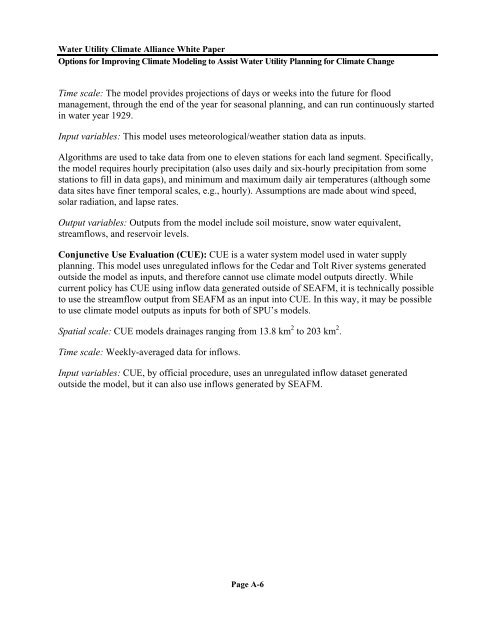Options for Improving Climate Modeling to Assist Water Utility ...
Options for Improving Climate Modeling to Assist Water Utility ...
Options for Improving Climate Modeling to Assist Water Utility ...
Create successful ePaper yourself
Turn your PDF publications into a flip-book with our unique Google optimized e-Paper software.
<strong>Water</strong> <strong>Utility</strong> <strong>Climate</strong> Alliance White Paper<br />
<strong>Options</strong> <strong>for</strong> <strong>Improving</strong> <strong>Climate</strong> <strong>Modeling</strong> <strong>to</strong> <strong>Assist</strong> <strong>Water</strong> <strong>Utility</strong> Planning <strong>for</strong> <strong>Climate</strong> Change<br />
Time scale: The model provides projections of days or weeks in<strong>to</strong> the future <strong>for</strong> flood<br />
management, through the end of the year <strong>for</strong> seasonal planning, and can run continuously started<br />
in water year 1929.<br />
Input variables: This model uses meteorological/weather station data as inputs.<br />
Algorithms are used <strong>to</strong> take data from one <strong>to</strong> eleven stations <strong>for</strong> each land segment. Specifically,<br />
the model requires hourly precipitation (also uses daily and six-hourly precipitation from some<br />
stations <strong>to</strong> fill in data gaps), and minimum and maximum daily air temperatures (although some<br />
data sites have finer temporal scales, e.g., hourly). Assumptions are made about wind speed,<br />
solar radiation, and lapse rates.<br />
Output variables: Outputs from the model include soil moisture, snow water equivalent,<br />
streamflows, and reservoir levels.<br />
Conjunctive Use Evaluation (CUE): CUE is a water system model used in water supply<br />
planning. This model uses unregulated inflows <strong>for</strong> the Cedar and Tolt River systems generated<br />
outside the model as inputs, and there<strong>for</strong>e cannot use climate model outputs directly. While<br />
current policy has CUE using inflow data generated outside of SEAFM, it is technically possible<br />
<strong>to</strong> use the streamflow output from SEAFM as an input in<strong>to</strong> CUE. In this way, it may be possible<br />
<strong>to</strong> use climate model outputs as inputs <strong>for</strong> both of SPU’s models.<br />
Spatial scale: CUE models drainages ranging from 13.8 km 2 <strong>to</strong> 203 km 2 .<br />
Time scale: Weekly-averaged data <strong>for</strong> inflows.<br />
Input variables: CUE, by official procedure, uses an unregulated inflow dataset generated<br />
outside the model, but it can also use inflows generated by SEAFM.<br />
Page A-6

















